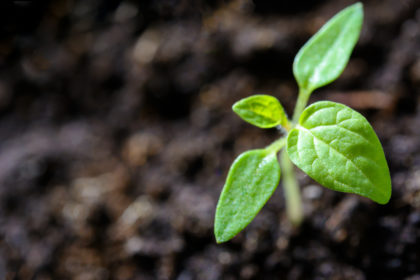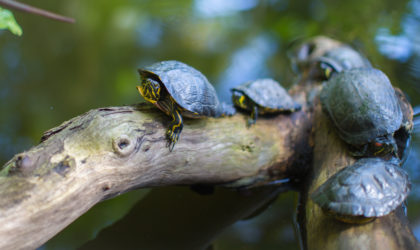
Driving along the Pennsylvania Turnpike this weekend, I experienced quite the assortment of billboards and DIY roadside messages. One that stood out “loudly” proclaimed that carbon dioxide is essential for life. By itself, that statement seems banally accurate. We could of course hypothesize that life elsewhere in the universe (or multiverse?) employs different sorts of chemistry; silicon is a popular first choice for a possible carbon substitute, although it is far from a direct replacement. But life as we know it, and certainly life as we personally experience it, depends on plants storing solar energy in molecules they assemble from atmospheric carbon dioxide–energy that we and other animals can access by eating plants and breaking those molecules back down again into carbon dioxide. So did someone really spend all that money just to promote awareness of a grade school science fact?
A bit of Googling once I was safely off the road revealed, to no surprise, that the organization responsible for the sign has more to say about the subject of carbon dioxide. Of course, carbon dioxide is not just produced by humans and animals when we eat plants and other food; it is also produced when we burn fossil fuels. Plants don’t care how the carbon dioxide gets into the atmosphere, they will gladly take it however they can get it. And there is plenty of solar energy arriving all the time that those plants can store in larger carbon molecules. So more carbon dioxide can lead to more and/or bigger plants, and isn’t that something we want?
Indeed, all else being equal, more and bigger plants would quite likely be a good thing. We’ll need more food for a growing global population, plant-based foods are a good source of nutrition, and non-edible green spaces appear to have meaningful mental health benefits. But I’m sure you know that there is more to the carbon dioxide story. More carbon dioxide leads to more solar energy being stored by the Earth and its atmosphere, not just as carbon molecules in plants, but also as heat, resulting in a warmer overall temperature. Here, the billboard folks are skeptical, raising questions about the temperature data that shows this warming trend. And as you might expect, other organizations are skeptical of that skepticism, identifying factors under-discussed or overlooked entirely by the first group.
I’ll assume you don’t need me to go further into the basics of the climate change science, and that’s not my primary interest here anyway. Rather, it got me thinking about how one knows when to wrap up an investigation into the issues and questions and follow-up questions and tertiary effects and so on. For example, yes, plants are a good source of nutrition, and yes, more carbon dioxide can lead to more and/or bigger plants. However, when we go to check of the obvious syllogistic inference that more carbon dioxide can lead to more sources of good nutrition, the answer is less clear. The nutrition from plants is more than just the solar-energy-bearing carbon molecules; it also includes micronutrients like zinc and potassium. More carbon dioxide doesn’t make more zinc or potassium, and so over time at least some important food crops appear to have fewer of these micronutrients per calorie. How significant of an impact that change has had and future changes will have likely depends on what country you live in which impacts your overall diet and your options for other sources of micronutrients. And so on.

Or consider an issue raised on a podcast I was listening to as I drove along the turnpike: beef consumption. Cows raised for beef are a significant source of methane, another gas that can cause solar energy to build up here and warm the Earth. Eating less beef should therefore reduce methane emissions from cattle and help reduce further warming. However, what the scientist interviewed on the podcast has found is that grazing animals like beef cattle can have ecological effects that promote plant growth and soil carbon retention. If the cattle are managed properly and if the grazing land is of the appropriate type, this could actually more than offset the methane production. The key is to keep the cattle moving over long distances, so that they graze a little here, then move on and graze a little there, then move on again. This style of grazing gives any given spot time for the plants to recover and can improve soil quality, potentially transforming land that would otherwise not be viable agriculturally. We likely can’t get unlimited beef from this strategy, but it does add further nuance to the discussion of beef and climate.
If you follow these or other threads, I’m sure you can find further questions and additional switchbacks that qualify any possible choice one could make even further. When are you done, either as a scientist doing the actual research or as a layman trying to become educated and make informed decisions? Philosophically, this is likely a version of the questions around justification and the Münchhausen trilemma. Despite the absence of a single resolution to the trilemma, we still occasionally have to make decisions. For questions amenable to scientific investigation, we can adopt an iterative approach, making choices based on available data and then checking regularly to see if the results of our choices are the ones we desired and making further adjustments or inquiries when we get unexpected outcomes. This requires a substantial amount of patience to wait for those results and of grace for ourselves and others to cover those times when hindsight reveals that a different choice from the one we made would have gotten us closer to where we wanted to go. Oddly enough, I had to practice that too on my highway journey. Engrossed as I was in a podcast, I missed an exit and had to get off at the next one, then exit from *that* road to be able to loop around in the other direction, get back on the previous road and then finally take the exit I originally wanted. I eventually got where I needed to go that way, and with a little grace and patience perhaps we can all get where we need to go too.
Andy has worn many hats in his life. He knows this is a dreadfully clichéd notion, but since it is also literally true he uses it anyway. Among his current metaphorical hats: husband of one wife, father of two teenagers, reader of science fiction and science fact, enthusiast of contemporary symphonic music, and chief science officer. Previous metaphorical hats include: comp bio postdoc, molecular biology grad student, InterVarsity chapter president (that one came with a literal hat), music store clerk, house painter, and mosquito trapper. Among his more unique literal hats: British bobby, captain’s hats (of varying levels of authenticity) of several specific vessels, a deerstalker from 221B Baker St, and a railroad engineer’s cap. His monthly Science in Review is drawn from his weekly Science Corner posts — Wednesdays, 8am (Eastern) on the Emerging Scholars Network Blog. His book Faith across the Multiverse is available from Hendrickson.

The problem is all the more complicated when one group wants to use the knowledge to promote or resist a policy change.
Turning research into policy is indeed challenging. As we have witnessed so dramatically in recent months, sometimes there is a genuine urgency to make policy decisions; with exponential growth, a decent policy today may very well yield greater benefits than an excellent policy next week. But even better, and where we really struggled in practice, is implementing a decent policy today and then replacing it with an excellent policy next week. Instead, there seemed to be an expectation that there was one right answer and one chance to articulate it and implement it, and anything else was waffling or manipulating the truth or playing politics or just too complicated and therefore ignored. I imagine part of that is the human psychological bias to prefer confidence over correctness. Another part may derive from overselling science as always already having all the answers, instead of being a process by which we eventually arrive at some answers. And yet another part may simply have stemmed from long-standing mistrust of scientists in some communities, such that no answer would be accepted no matter how simple or complex, or how definitive or qualified.